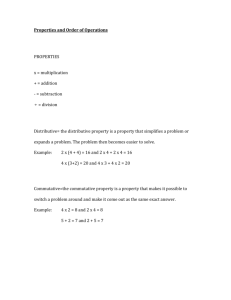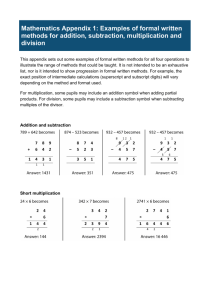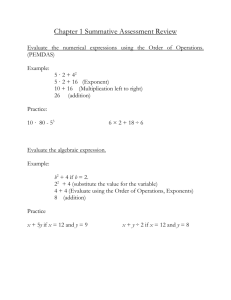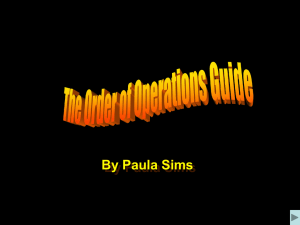Have the order of operations changed?
advertisement
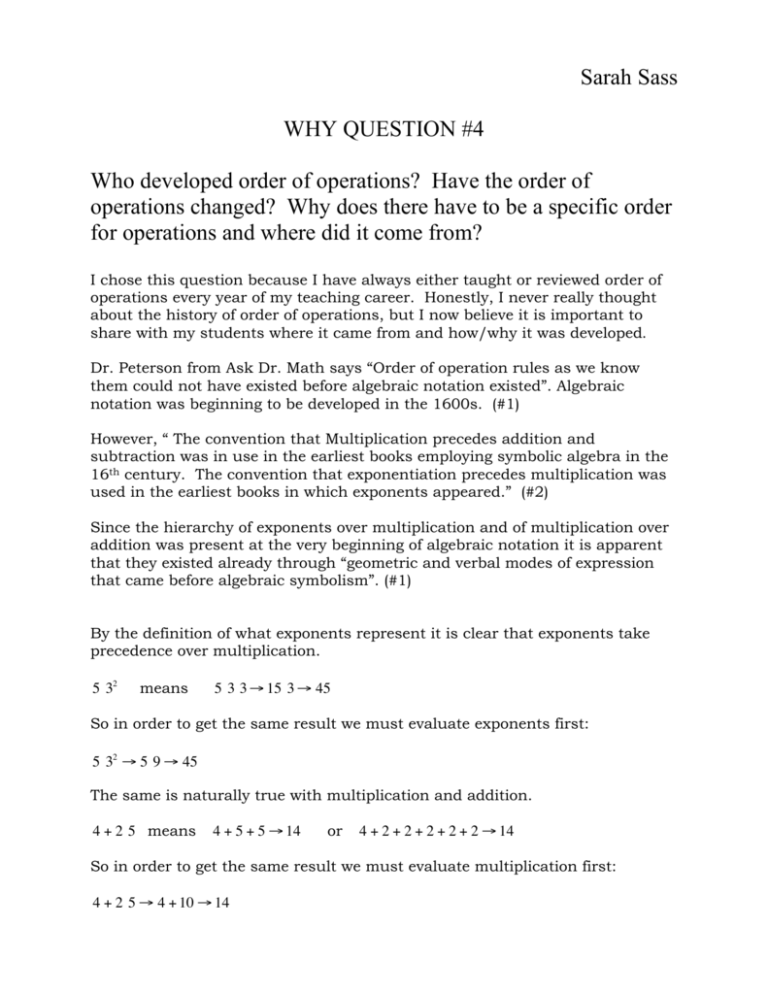
Sarah Sass WHY QUESTION #4 Who developed order of operations? Have the order of operations changed? Why does there have to be a specific order for operations and where did it come from? I chose this question because I have always either taught or reviewed order of operations every year of my teaching career. Honestly, I never really thought about the history of order of operations, but I now believe it is important to share with my students where it came from and how/why it was developed. Dr. Peterson from Ask Dr. Math says “Order of operation rules as we know them could not have existed before algebraic notation existed”. Algebraic notation was beginning to be developed in the 1600s. (#1) However, “ The convention that Multiplication precedes addition and subtraction was in use in the earliest books employing symbolic algebra in the 16th century. The convention that exponentiation precedes multiplication was used in the earliest books in which exponents appeared.” (#2) Since the hierarchy of exponents over multiplication and of multiplication over addition was present at the very beginning of algebraic notation it is apparent that they existed already through “geometric and verbal modes of expression that came before algebraic symbolism”. (#1) By the definition of what exponents represent it is clear that exponents take precedence over multiplication. 5 32 means 5 3 3 ! 15 3 ! 45 So in order to get the same result we must evaluate exponents first: 5 32 ! 5 9 ! 45 The same is naturally true with multiplication and addition. 4 + 2 5 means 4 + 5 + 5 ! 14 or 4 + 2 + 2 + 2 + 2 + 2 ! 14 So in order to get the same result we must evaluate multiplication first: 4 + 2 5 ! 4 + 10 ! 14 The big dilemma was with multiplication and division. (#2) In 1892 in Mental Arithmetic, M. A. Bailey advises avoiding expressions containing both ÷ and ×. In 1898 in Text-Book of Algebra by G. E. Fisher and I. J. Schwatt, a÷b×b is interpreted as (a÷b)×b. In 1907 in High School Algebra, Elementary Course by Slaught and Lennes, it is recommended that multiplications in any order be performed first, then divisions as they occur from left to right. In 1910 in First Course of Algebra by Hawkes, Luby, and Touton, the authors write that ÷ and × should be taken in the order in which they occur. In 1912, First Year Algebra by Webster Wells and Walter W. Hart has: "Indicated operations are to be performed in the following order: first, all multiplications and divisions in their order from left to right; then all additions and subtractions from left to right." In 1913, Second Course in Algebra by Webster Wells and Walter W. Hart has: "Order of operations. In a sequence of the fundamental operations on numbers, it is agreed that operations under radical signs or within symbols of grouping shall be performed before all others; that, otherwise, all multiplications and divisions shall be performed first, proceeding from left to right, and afterwards all additions and subtractions, proceeding again from left to right." In 1917, "The Report of the Committee on the Teaching of Arithmetic in Public Schools," Mathematical Gazette 8, p. 238, recommended the use of brackets to avoid ambiguity in such cases. In A History of Mathematical Notations (1928-1929) Florian Cajori writes (vol. 1, page 274), "If an arithmetical or algebraical term contains ÷ and ×, there is at present no agreement as to which sign shall be used first." Modern textbooks seem to agree that all multiplications and divisions should be performed in order from left to right. My question: Did this same debate occur with the order of addition and subtraction? I found no information about it. Dr Peterson suspects “that the concept, and especially the term "order of operations" and the "PEMDAS/BEDMAS" mnemonics, was formalized only in this century, or at least in the late 1800s, with the growth of the textbook industry. I think it has been more important to text authors than to mathematicians, who have just informally agreed without needing to state anything officially.” (#1) The acronym PEMDAS or Please Excuse My Dear Aunt Sally can be misleading to students. It is easy to interpret the acronyms to mean that multiplication should be done before division (instead of from left to right) and addition should be done before subtraction (instead of from left to right). “There is a new mnemonic featured in Danica McKellar's books Math Doesn't Suck[2] and Kiss My Math[3] that does address this very issue: "Pandas Eat: Mustard on Dumplings, and Apples with Spice." The intention being that Mustard and Dumplings is a "dinner course" and that Apples and Spice is a "dessert course." Then it becomes not a linear string of operations to do one after the other, but rather the "dinner course" operations are considered together and performed left to right, and then addition and subtraction are considered together, again performed again left to right. “ (#3) In CPM (College Preparatory Mathematics) textbooks students are taught to circle terms (terms are separated by addition and subtraction signs), then simplify each term until it is one number and then complete the problem from left to right. Students are told to do parentheses 1st and exponents before multiplication. EX: 4(5 + 3) ! 2 32 + 18 ÷ 6 1st term: 4(5 + 3) ! 4(8) ! 32 2nd term: 2 32 ! 2 9 ! 18 3rd term: 18 ÷ 6 ! 3 Then you would have: 32 ! 18 + 3 = 17 #1: mathforum.org/library/drmath/view/52582.html #2: http://jeff560.tripod.com/operation.html #3: en.wikipedia.org/wiki/Order_of_operations#The_standard_order_of_operations




